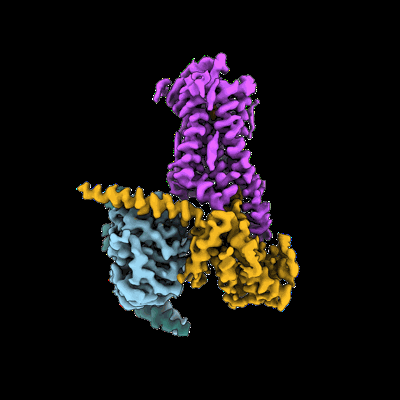EMD-29953
CryoEM structure of beta-2-adrenergic receptor in complex with nucleotide-free Gs heterotrimer (#3 of 20)
EMD-29953
Single-particle3.3 Å
 Deposition: 06/03/2023
Deposition: 06/03/2023Map released: 06/03/2024
Last modified: 13/11/2024
Sample Organism:
Homo sapiens
Sample: Complex of beta-2 adrenergic receptor and Gs G protein heterotrimer
Fitted models: 8ge2 (Avg. Q-score: 0.51)
Raw data: EMPIAR-11855
Deposition Authors: Papasergi-Scott MM ,
Skiniotis G
,
Skiniotis G 
Sample: Complex of beta-2 adrenergic receptor and Gs G protein heterotrimer
Fitted models: 8ge2 (Avg. Q-score: 0.51)
Raw data: EMPIAR-11855
Deposition Authors: Papasergi-Scott MM
 ,
Skiniotis G
,
Skiniotis G 
Time-resolved cryo-EM of G-protein activation by a GPCR.
Papasergi-Scott MM  ,
Perez-Hernandez G
,
Perez-Hernandez G  ,
Batebi H
,
Batebi H  ,
Gao Y
,
Gao Y  ,
Eskici G
,
Eskici G  ,
Seven AB
,
Seven AB  ,
Panova O
,
Panova O  ,
Hilger D
,
Hilger D  ,
Casiraghi M,
He F
,
Casiraghi M,
He F  ,
Maul L,
Gmeiner P
,
Maul L,
Gmeiner P  ,
Kobilka BK
,
Kobilka BK  ,
Hildebrand PW
,
Hildebrand PW  ,
Skiniotis G
,
Skiniotis G 
(2024) Nature , 629 , 1182 - 1191
 ,
Perez-Hernandez G
,
Perez-Hernandez G  ,
Batebi H
,
Batebi H  ,
Gao Y
,
Gao Y  ,
Eskici G
,
Eskici G  ,
Seven AB
,
Seven AB  ,
Panova O
,
Panova O  ,
Hilger D
,
Hilger D  ,
Casiraghi M,
He F
,
Casiraghi M,
He F  ,
Maul L,
Gmeiner P
,
Maul L,
Gmeiner P  ,
Kobilka BK
,
Kobilka BK  ,
Hildebrand PW
,
Hildebrand PW  ,
Skiniotis G
,
Skiniotis G 
(2024) Nature , 629 , 1182 - 1191
Abstract:
G-protein-coupled receptors (GPCRs) activate heterotrimeric G proteins by stimulating guanine nucleotide exchange in the Gα subunit1. To visualize this mechanism, we developed a time-resolved cryo-EM approach that examines the progression of ensembles of pre-steady-state intermediates of a GPCR-G-protein complex. By monitoring the transitions of the stimulatory Gs protein in complex with the β2-adrenergic receptor at short sequential time points after GTP addition, we identified the conformational trajectory underlying G-protein activation and functional dissociation from the receptor. Twenty structures generated from sequential overlapping particle subsets along this trajectory, compared to control structures, provide a high-resolution description of the order of main events driving G-protein activation in response to GTP binding. Structural changes propagate from the nucleotide-binding pocket and extend through the GTPase domain, enacting alterations to Gα switch regions and the α5 helix that weaken the G-protein-receptor interface. Molecular dynamics simulations with late structures in the cryo-EM trajectory support that enhanced ordering of GTP on closure of the α-helical domain against the nucleotide-bound Ras-homology domain correlates with α5 helix destabilization and eventual dissociation of the G protein from the GPCR. These findings also highlight the potential of time-resolved cryo-EM as a tool for mechanistic dissection of GPCR signalling events.
G-protein-coupled receptors (GPCRs) activate heterotrimeric G proteins by stimulating guanine nucleotide exchange in the Gα subunit1. To visualize this mechanism, we developed a time-resolved cryo-EM approach that examines the progression of ensembles of pre-steady-state intermediates of a GPCR-G-protein complex. By monitoring the transitions of the stimulatory Gs protein in complex with the β2-adrenergic receptor at short sequential time points after GTP addition, we identified the conformational trajectory underlying G-protein activation and functional dissociation from the receptor. Twenty structures generated from sequential overlapping particle subsets along this trajectory, compared to control structures, provide a high-resolution description of the order of main events driving G-protein activation in response to GTP binding. Structural changes propagate from the nucleotide-binding pocket and extend through the GTPase domain, enacting alterations to Gα switch regions and the α5 helix that weaken the G-protein-receptor interface. Molecular dynamics simulations with late structures in the cryo-EM trajectory support that enhanced ordering of GTP on closure of the α-helical domain against the nucleotide-bound Ras-homology domain correlates with α5 helix destabilization and eventual dissociation of the G protein from the GPCR. These findings also highlight the potential of time-resolved cryo-EM as a tool for mechanistic dissection of GPCR signalling events.
